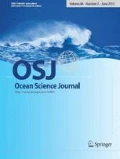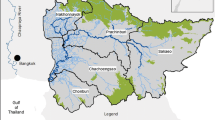Abstract
A major source of nutrient load to periodically hypoxic Manila Bay is the urban nutrient waste water flow from humans and industries to surface water. In Manila alone, the population density is as high as 19,137 people/km2. A model based on a global point source model by Morée et al. (2013) was used to estimate the contribution of the population to nitrogen and phosphorus emissions which was then used in a water transport model to estimate the nitrogen (N) and phosphorus (P) loads to Manila Bay. Seven scenarios for 2050 were tested, with varying degrees and amounts for extent of sewage treatment, and population growth rates were also included. In scenario 1, the sewage connection and treatment remains the same as 2010; in scenario 2, sewage connection is improved but the treatment is the same; in scenario 3, the sewage connection as well as treatment is improved (70% tertiary); and in scenario 4, a more realistic situation of 70% primary treatment achieved with 100% connection to pipes is tested. Scenarios 5, 6, and 7 have the same parameters as 1, 2, and 3 respectively, but with the population growth rate per province reduced to half of what was used in 1, 2, and 3. In all scenarios, a significant increase in N and P loads was observed (varying from 27% to 469% relative to 2010 values). This was found even in scenario 3 where 70% of the waste water undergoes tertiary treatment which removes 80% N and 90% P. However, the lowest increase in N and P load into the bay was achieved in scenarios 5 to 7 where population growth rate is reduced to half of 2010 values. The results suggest that aside from improving sewage treatment, the continued increase of the human population in Manila at current growth rates will be an important determinant of N and P load into Manila Bay.
Similar content being viewed by others
References
Block RJ, Bolling D (1946) The amino acid composition of proteins and foods. Science 103(2675): 431–432
BSWM (2012) Assessment of non-point source pollution from croplands of the Manila Bay System. Bureau of Soils and Water Management, Quezon City
FAO (2010) Philippines: food security indicators. FAOSTAT. http://www.fao.org/fileadmin/templates/ess/documents/food_security_ statistics/country_profiles/eng/Philippines_E.pdf Accessed 25 June 2014
GEF (2005) Manila Third Sewarage Project.
Jacinto GS, Sotto LPA, Senal MIS, San Diego-McGlone ML, Escobar MTL, Amano A, Miller TW (2011) Hypoxia in Manila Bay, Philippines during the northeast monsoon. Mar Pollut Bull 63:243–248. doi:10.1016/j.marpolbul.2011.02.026
Jarvis A, Reuter HI, Nelson A, Guevara E (2008) Hole-filled SRTM for the globe Version 4. CGIAR-CSI SRTM 90m Database. http://srtm.csi.cgiar.org
Morée AL, Beusen AHW, Bouwman AF, Willems WJ (2013) Exploring global nitrogen and phosphorus fl ows in urban wastes during the twentieth century. Global Biogeochem Cy 27:836–846. doi:10.1002/gbc.20072
NSO (2010) Census of Population and Housing Reports. Philippines Statistics Athority, National Statistics Office
Olchondra RT (2011) Manila water intensifies sewer-drainage upgrade, expansion. Philippines Daily Inquirer. http://business.inquirer.net/2437/manila-water-intensifies-sewer-drainageupgrade-expansion Accessed 24 May 2011
PEMSEA, MBEMP-MBIN (2007) Manila Bay area environmental atlas, PEMSEA technical report 20. Global Environment Facility, United Nations Development Programme, International Maritime Organization Regional Programme on Building Parterships in Environmental Management for the Seas of East Asia (PEMSEA) and the Manila Bay Environmental Management, Quezon City, Philippines.
Smith SV, Swaney DP, Talaue -McManus L, Bartley JD, Sandhei PT, McLaughlin CJ, Dupra VC, Crossland CJ, Buddemeier RW, Maxwell BA, Wulff F (2003) Humans, hydrology, and the distribution of inorganic nutrient loading to the ocean. Bioscience 53:235–245
Sotto LPA, Jacinto GS, Villanoy CL (2014) Spatiotemporal variability of hypoxia and eutrophication in Manila Bay, Philippines during the northeast and southwest monsoons. Mar Pollut Bull 85:446–454. doi:10.1016/j.marpolbul.2014.02.028
Svirejeva-Hopkins A, Reis S, Magid J, Nardoto GB, Barles S, Bouwman AF, Erzi I, Kousoulidou M, Howard CM, Sutton MA (2011) Nitrogen flows and fate in urban landscapes. in: Sutton MA, Howard CM, Erisman JW, Billen G, Bleeker A, Grennfelt P, Grinsven H, Grizzetti B (eds) European nitrogen assessment. Cambridge University Press, Cambridge, UK, pp 12
The World Bank (2012) Implementation status and results: Manila Third Sewerage Project.
Van Drecht G, Bouwman AF, Harrison J, Knoop JM (2009) Global nitrogen and phosphate in urban wastewater for the period 1970 to 2050. Global Biogeochem Cy 23:1–19. doi:10.1029/2009GB003458
Author information
Authors and Affiliations
Corresponding author
Rights and permissions
About this article
Cite this article
Sotto, L.P.A., Beusen, A.H.W., Villanoy, C.L. et al. Nutrient load estimates for Manila Bay, Philippines using population data. Ocean Sci. J. 50, 467–474 (2015). https://doi.org/10.1007/s12601-015-0042-0
Received:
Revised:
Accepted:
Published:
Issue Date:
DOI: https://doi.org/10.1007/s12601-015-0042-0




